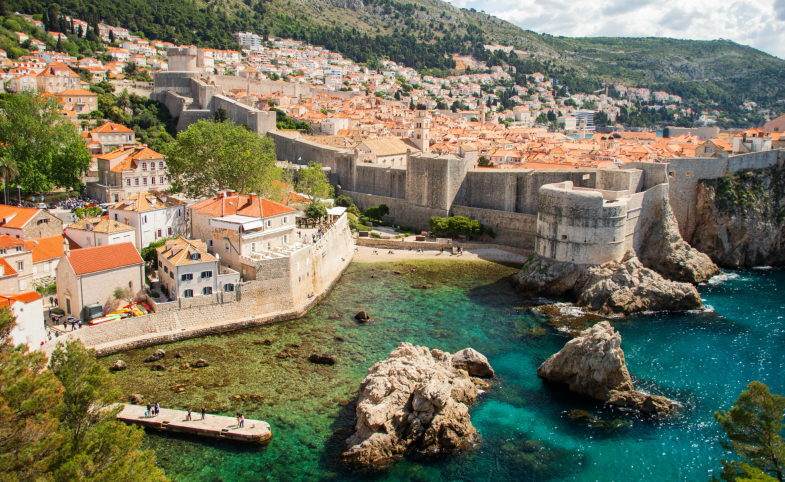With a population of 216 million and a distinct culture of fan fervor, Brazil is a unique region for cultural exchange and diplomacy. American sports teams and entertainers have shown a new dedication to the Brazilian...
KEEP READINGThe CPD Blog is intended to stimulate dialog among scholars and practitioners from around the world in the public diplomacy sphere. The opinions represented here are the authors' own and do not necessarily reflect CPD's views. For blogger guidelines, click here.

Dubrovnik’s Enduring Legacy of Strategic Public Diplomacy
Dubrovnik, known as the "Pearl of the Adriatic," has become a major tourist destination celebrated for its cultural significance and material heritage. As the iconic setting of the Game of Thrones, boasting colossal fortifications, the city has managed to preserve its historic legacy as a small but remarkably skilled republic.
Guided by the art of diplomacy, the Republic of Dubrovnik (Latin: Ragusa) endured for centuries at the line between the great powers of East and West. The people of Dubrovnik were astute political strategists, demonstrating not only an exceptional capacity for calibrated and strategic decision-making, but also for early forms of public diplomacy. Although the term public diplomacy had not yet been coined, this article examines how Dubrovnik, as early as the 14th century, employed practices that closely align with its modern-day principles.
Understanding the historical context is essential to fully grasp the significance of the Republic of Dubrovnik. "The birth certificate" of the Republic was inscribed in a complex political and geographical landscape. As a Catholic enclave in a region deeply influenced by both Eastern Orthodoxy and Islam, Dubrovnik developed a highly sophisticated diplomatic apparatus, transforming its challenging geopolitical position into a strategic advantage. Thanks to its wise and pragmatic foreign policy, the Republic emerged as a crucial bridge between differing worldviews. Moreover, by recognizing the value of information, it became one of Europe’s key intelligence centers in the 16th and 17th centuries.
The Republic of Dubrovnik’s commitment to preserving its existence and freedom was directed toward the development of all necessary tools to ensure its survival. Particularly well-developed was the sense of public opinion and public relations. A prime example is the strategic hosting of the Tuscan scholar Filippo Diversi, whom the Dubrovnik authorities invited to teach the nobility. Enthralled by the city's beauty and lifestyle, Diversi wrote Descriptio of the City of Dubrovnik, in which he portrayed the historical identity of Dubrovnik, creating a refined and favorable image of the city and its people. This text was the first comprehensive depiction of Dubrovnik and, at the same time, a carefully crafted diplomatic tool, consciously sent out into the world to shape a positive image of the Republic abroad.
Particular significance in Dubrovnik’s diplomacy was given to protocol. Leaders were acutely aware of the importance of the messages conveyed through state ceremonies, which made every public appearance of the Rector meticulously planned and regulated by strictly-defined rules. State ceremonies were highly theatrical, as they represented the only form of communication between the authorities and both the citizens and foreign representatives, long before the advent of newspapers and modern media. So, the delegation that Dubrovnik sent to Višegrad in 1358 for the purpose of signing the independence treaty was carefully prepared. The delegation appeared in their finest attire, dressed in purple robes and velvet cloaks trimmed with ermine: all emblems of national sovereignty. This became a remarkable example of political marketing where symbolism and impression played a crucial role in strengthening the international image of the Republic.
Another example is the role of poklisari - special envoys appointed for high-level diplomatic missions. Their selection was conducted with great care; only highly educated, eloquent, and respected members were eligible. Prior to departure, these envoys received detailed instructions regarding their conduct and communication to ensure that the Republic’s message was conveyed as effectively as possible. Also, their departure was marked by a formal ceremony: under the Republic’s flag, the nobility and citizens solemnly saw them off, subtly concealing the political sensitivity of tribute missions to the Sultan’s court.
Dubrovnik’s diplomacy was distinguished by its deep understanding of Eastern politics. Recognizing the permanence of Ottoman rule in the Balkans, Dubrovnik developed sophisticated communication methods with Ottoman rulers. Diplomats trained as dragomans (interpreters) in Arabic and Turkish accompanied envoys, ensuring clear communication and adapting messages for the Ottoman authorities. The special relationship between the Ottoman Empire and Dubrovnik was reflected in the distinct location of Dubrovnik’s embassy in Constantinople, separate from other European embassies. Also, to strengthen diplomatic ties, envoys frequently brought carefully selected gifts: not only for the Sultan but also for his wives and daughters. These gifts often included Dubrovnik’s renowned spices and delicacies, such as almond cakes and kotonjata (quince cheese). In this, one might recognize an early form of what is today known as culinary diplomacy.
Established in the 13th century to protect maritime and commercial interests, the Republic's consular service created a network across Europe, bolstering its economic and diplomatic power. In practice, it became customary to identify reputable individuals in foreign cities willing to cooperate with Dubrovnik and report on important political and economic events. These individuals were entrusted with acting in the Republic’s interest, laying the foundation for the concept of the honorary consul - a Dubrovnik innovation that became a lasting contribution to global diplomatic history
By the mid-18th century, Dubrovnik had over 80 consulates in Europe, surpassing the consular networks of other European powers, which had only about thirty at the time. Also, Francesco Favi, the Republic’s envoy in France, recognized the growing importance of fledgling America and advised the Senate to formally acknowledge its independence. His initiative led to a meeting with U.S. representative Benjamin Franklin in Paris (same link), making Dubrovnik one of the first countries to de facto recognize America's independence. The Republic and its diplomats operated in a multicultural, multilingual environment, so diplomats were trained in multiple languages - Latin, Italian, French, and Turkish. In addition to linguistic proficiency, diplomats were required to have a comprehensive understanding of political theory.
Dubrovnik’s diplomacy relied on a range of strategic tools to shape and promote its image as a free, cultured, and educated society. The Republic took pride in its achievements in science, literature, music, and medicine. So, the authorities frequently selected promising young individuals and sent them to study at prestigious European academic centers. These scholars not only acquired knowledge and prestige but also gained diplomatic experience, which later enabled them to effectively represent the Republic’s interests on the international stage. As a result, the name of Dubrovnik became well known within scientific circles and demonstrated its strong commitment to education and intellectual excellence. Among its notable diplomats were Marin Getaldić, a distinguished mathematician and pioneer in the field of optics; Ruđer Bošković, a physicist and astronomer; and Benedikt Kotrulj, author of one of the most significant early works in the history of economics. These exemplify the intertwining of science and diplomacy.
"Through its diplomatic skill, Dubrovnik not only enriched its own homeland, the Republic of Croatia, but also left a lasting mark on global history and diplomacy."
Also, the humanitarian efforts of the Dubrovnik Republic included a wide range of health and social initiatives. Institutions like Opera Pia established public foundations for the poor and travelers, providing food, healthcare, and education. A quarantine station and hospice were opened in the 14th century, followed by the first orphanage in the 15th century. In 1416, the Republic outlawed the slave trade, becoming one of the first states to do so - a move often regarded as a reflection of its advanced ethical values. Also, one of Europe’s oldest still-operating pharmacies also began in Dubrovnik. These initiatives collectively contributed to the Republic’s reputation as a humane and socially conscious community.
Culture was a key element of Dubrovnik’s foreign policy. Its diplomacy was intellectually engaged with major Renaissance and Baroque centers of Europe. Figures like Luka Sorkočević, both composer and diplomat, used the universal language of music to build international ties. The Republic also actively supported the printing and dissemination of its own literary works, such as those by Marin Držić and Ivan Gundulić, further integrating Dubrovnik into the cultural fabric of Western Europe.
Another key aspect of Dubrovnik’s cultural diplomacy was the hospitality extended to foreign artists, scientists, and intellectuals in the city’s renowned summer residences, which fostered a rich environment for cultural exchange.
Religious symbols also played a significant role in the diplomacy of the Republic - most notably Saint Vlaho (known as Blaise in English), the patron saint of the Republic, whose image held deep symbolic power. Churches dedicated to Saint Vlaho were established even in distant regions such as Goa in India, and his banner was widely recognized throughout the Catholic world. The presence and veneration of Saint Vlaho were seen as clear symbols of Dubrovnik’s cultural and political influence.
The Republic of Dubrovnik's economy was driven by maritime trade with key routes to ports like Antwerp and Southampton. Its influence in England is reflected in Pasqua Rosée, an ethnic Greek born in Dubrovnik who opened England’s first coffeehouse in 1652. Dubrovnik's large merchant ships impressed English observers, and this legacy endures in the word argosy - derived from “Ragusa”- which Shakespeare helped popularize to denote sizeable trading vessels.
All of this reinforced Dubrovnik’s image as an oasis of freedom, culture, and academic excellence at the crossroads of the Christian and Ottoman worlds.
Through its diplomatic skill, Dubrovnik not only enriched its own homeland, the Republic of Croatia, but also left a lasting mark on global history and diplomacy. Today, Dubrovnik’s diplomatic legacy is frequently referenced in discussions on the power of public diplomacy. In academic circles, its strategies are often analyzed as case studies, showcasing the Republic's innovative approaches to preserving sovereignty. Rather than demonstrating power, Dubrovnik built its reputation on reliability and utility: presenting itself not as a threat, but as a necessary and constructive partner. In this way, the Republic of Dubrovnik remains not only a pearl of Croatian history, but also a universal example of the power of public diplomacy in promoting peace and cooperation.
Visit CPD's Online Library
Explore CPD's vast online database featuring the latest books, articles, speeches and information on international organizations dedicated to public diplomacy.
POPULAR ARTICLES
-
November 3
-
November 5
-
November 13
-
November 25
-
December 17
Join the Conversation
Interested in contributing to the CPD Blog? We welcome your posts. Read our guidelines and find out how you can submit blogs and photo essays >.













